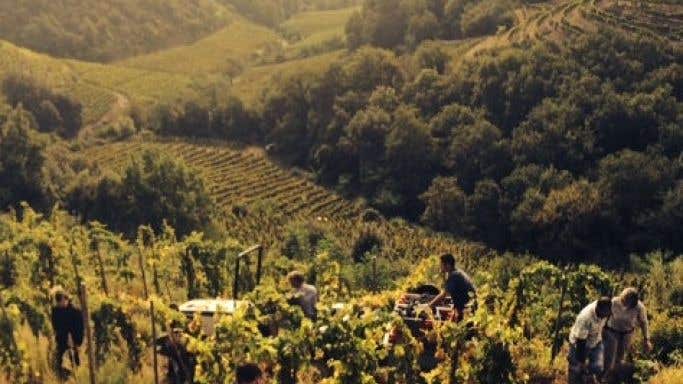If there's one sure sign of autumn in full swing for the wine trade, it's the influx of vintage reports hitting inboxes. Here are a few snippets of what we've heard, quite literally, on the grapevine. The image is kindly provided by Jean-Luc Colombo in Cornas.
Champagne
A 'perfect' September saved the 2014 crop of Champagne fruit, according to G.H. Mumm, undoing the very wet August with warm drying winds. This stopped any rot developing and allowed 'optimum ripeness' to be reached. Mumm report that their average vineyard yield 'was around 15,000 kg/ha. This allowed the pickers to be very selective in the vineyards in order to reach the maximum yield of 10,500 kg/ha plus 3,100 kg/ha for reserves set down by the Comité Champagne. Potential alcohol levels were good at 10 ° for Chardonnay, 10.02 ° for Pinot Noir and 9.5 ° for Pinot Meunier, requiring very little chaptalisation. Acidity levels were slightly lower than in 2013 with an average of 8.29 g/l and average pH of 3.02.'
Loire
Courtier Charles Sydney declares that '2014 is looking pretty damn good so far.' Early summer produced good conditions for flowering, then a cooler August but hot September meant there was plenty of time to ripen the fruit without risk of rot. Some storms on 19 September damaged St-Pourçain in particular, with 80% of bunches being hit by hail. For Muscadet and the Sauvignon appellations, however, 'the harvest was in as near perfect conditions as you can get', with Chenin harvest looking very promising too.
Chablis
In Chablis, spirits are high for the prospects of 2014. 'The skin is pale yellow, which shows the ripeness without excess, with thick, ripe skins. Health conditions was so good that sorting was carried on only to remove leaves. The juice has a remarkable balance, with nice acidity, without too much malic acid', says Gregory Viennois of Dom Laroche. The ripening season was extended thanks to early flowering and warm, dry conditions throughout summer, and yields are an improvement on the 2013 haul.
Bordeaux
See Gavin Quinney's comprehensive report.
Sauternes
The prospects for Sauternes hang (pun intended) in the balance, according to Bill Blatch of Bordeauxgold.com. At the beginning of October, there was very little sign of noble rot. Some initial tries have been undertaken, with 'harvest troops picking just two or three fully botrytised grapes per bunch'. If there is sufficient rain, the remaining fruit is ready to rot – if not, the results could be like 1988, with limited botrytis character but beautiful focus.
Languedoc
Grim news from the fruit basket of France, with this report that we are keeping anonymous: 'awful (very rainy) in Languedoc-Roussillon: vintage will be less bad than last year, mainly for red wines, but not excellent I'm afraid …'
Austria
Premium Estates of Austria, a consortium of six producers, reports that 'The 2014 harvest in Austria’s vineyards has been one of the most demanding and challenging of the past 10 years.' Cool summer temperatures and excessive rain are to blame, meaning that yields will be low, and that 'some of our crus might not be produced.' In Burgenland, the St. Laurent and Blaüfrankisch grapes have particularly suffered, although the final judgement as to quality is still pending. Elsewhere, the thin-skinned Muskateller was particularly susceptible to the rain.
In Styria, Willi Sattler apparently said 'he has never encountered such a demanding and stressful vintage' in 30 years of making wine, with a lack of ripeness and excessive rot thereatening quality. At least in Vienna, things are looking better for Grüner Veltliner, which has resisted the rain more succesfully.
Port and the Douro
Paul Symington writes of 'a challenging year in the Douro. We had a very wet period from December through to February with 44% more rain than normal. Apart from the difficulties encountered by those engaged in replanting vineyards, this rain was most welcome.' After an early budbreak, rainstorms hit again in early July, causing 'extraordinary damage, flooding the local railway station and precipitating an avalanche of rock and mud that destroyed the car of a well-known wine maker in the village (fortunately nobody was in the car at the time)'.
August was cooler than normal, in a similar way to 2007. Indeed at the beginning of harvest, 'the grapes were in really lovely condition; soft skins, full berries and balanced sugars and acidity, perfect for making great port and very good Douro wines. But Mother Nature was not in a mood to help us and the weather remained unsettled. In some areas this caused problems, in others the rain made little impact.' He confirms that 'it was not a glorious harvest right across the region as it might have been if the weather had held during September and overall yields will be down. It was a year to take full advantage of judicious vineyard investment in the best sub-regions'.
Tuscany

Pierro Antinori, pictured above, reports that the summer was very rainy, with lower temperatures than the norm – and admitted that 2014 is a 'challenging vintage' with far lower yields. For example, they expect to make half their average quantity of Solaia this year – 3,500 cases instead of 7,000. We published this report, Gloom in Barolo country, on a dire summer in Piemonte back in July and reports suggest that the challenging conditions persisted. The only region in Italy that seems happy with 2014 is Sicily, where vintners are delighted with the quality of grapes.
England
Budburst was early with generally warm temperatures throughout the English summer. Both Gusbourne and Nyetimber are positively giddy at the excellent quality of the fruit they have harvested – though yields are lower than in 2013.
USA
See Alder's very comprehensive report published yesterday.

